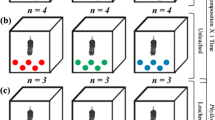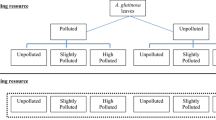Abstract
Both the absence of leaf shredding macroinvertebrates and low microbial activity are of major importance in determining slow and incomplete leaf decay in extremely acidic (pH<3.5) mining streams. These streams are affected by a heavy ochre deposition causing the formation of massive iron plaques on leaf surfaces that hinder microbial exploitation. An investigation was carried out to determine whether iron plaques and leaf conditioning status (acid conditioned with and without iron plaques, neutral conditioned, unconditioned) affect the feeding preference of the shredder Gammarus pulex (L.). Leaf respiration rates and fungal biomass (ergosterol contents) were measured to determine microbial colonization. Neutral conditioned leaves had significantly higher microbial colonization than acid conditioned leaves with iron plaques. Notwithstanding, leaves of both conditioning types were consumed at high rates by G. pulex. The microbial colonization had no influence on feeding preference in the experiment. It is presumed that iron adsorbed organic material caused the high palatability of leaves with iron plaques. The results indicate that the large deposits of leaves coated with iron plaques will be available to the stream food web when water quality will be restored to neutral as planed in scenarios for the future development of mining streams.
Similar content being viewed by others
References
Bärlocher F. (1985). The role of fungi in the nutrition of stream invertebrates. Botanical Journal of the Linnean Society 91: 83–86
Benfield E. F. (1996). Leaf breakdown in stream ecosystems. In: Hauer, F. R. and Lamberti, G. A. (eds) Methods in Stream Ecology, pp 579–589. Academic Press, Inc, San Diego
Burton T. M. (1985). Acidification effects on stream biota and organic matter processing. Canadian Journal of Fisheries and Aquatic Sciences 42: 669–675
Canhoto C. and Graça M. A. S. (1999). Leaf barriers to fungal colonization and shredders (Tipula lateralis) consumption of decomposing Eucalyptus globules. Microbial Ecology 37: 163–172
Cruz-Rivera E. and Hay M. E. (1998). Can quantity replace quality? Food choice, compensatory feeding and fitness of marine mesograzers. Ecology 81: 201–219
Cummins K. W. (1974). Structure and function of stream ecosystems. BioScience 24: 631–641
Dangles O., Gessner M. O., Guérold F. and Chauvet E. (2004). Impacts of stream acidification on litter breakdown: implications for assessing ecosystem functioning. Journal of Applied Ecology 41: 365–375
Dangles O. and Guérold F. (2001). Linking shredders and leaf litter processing: Insights from an acidic stream study. International Review of Hydrobiology 86: 395–406
DIN 38406-1, 1983. Deutsche Einheitsverfahren zur Wasser-, Abwasser- und Schlammuntersuchung (DEV), Kationen (Gruppe E), Bestimmung von Eisen, photometrisches Verfahren (E1). 1983-05.
Ferris F. G., Tazaki K. and Fyfe W. S. (1989). Iron oxides in acid mine drainage environments and their association with bacteria. Chemistry and Geology 74: 321–330
Friberg N. and Jacobsen D. (1994). Feeding plasticity of two detrivore-shredders. Freshwater Biology 32: 133–142
Fyson A., Nixdorf B., Kalin M. and Steinberg C. E. W. (1998). Mesocosm studies to assess acidity removal from acidic mine lakes through controlled eutrophication. Ecological Engineering 10: 229–245
Gessner M. O. and Schmitt A. L. (1996). Use of solid-phase extraction to determine ergosterol concentrations in plant tissues colonized by fungi. Applied and Environmental Microbiology 62: 415–419
Graça M. A. S. (1993). Patterns and processes in detritus-based stream systems. Limnologica 23: 107–114
Graça M. A. S., Cressa C., Gessner M. O., Feio M. J., Callies K. A. and Barrios C. (2001). Food quality, feeding preferences, survival and growth of shredders from temperate and tropical streams. Freshwater Biology 46: 947–957
Graça M. A. S., Maltby L. and Calow P. (1993). Importance of fungi in the diet of Gammarus pulex and Asellus aquaticus: II. Effects on growth, reproduction and physiology. Oecologia 96: 304–309
Klapper H., Friese K., Scharf B., Schimmele M. and Schultze M. (1998). Ways of controlling acid by ecotechnology. In: Geller, W., Klapper, H., and Salomons, W. (eds) Acidic Mining Lakes, pp 401–418. Springer, Berlin
(1998). A Guide to Kjeldahl Nitrogen Determination Methods and Apparatus. Industry Service Publication, Kansas City
Motomoro K., Mitsuhashi H. and Nakano S. (2001). Influence of leaf litter quality on the colonization and consumption of stream invertebrate shredders. Ecological Research 16: 173–183
Mutz M. (1998). Stream system restoration in a strip mining region, eastern Germany: dimension, problems and first steps. Aquatic Conservation: Marine and Freshwater Ecosystems 8: 159–166
Mutz M. and Schlief J. (2005). Scenario for undirected progression of extremely acidic streams in the Lusatian post-mining landscape. Ecological Engineering 24: 59–65
Niyogi D. K., Lewis W. M. and McKnight D. M. (2001). Litter breakdown in mountain streams affected by mine drainage: biotic mediation of abiotic controls. Ecological Applications 11: 506–516
Niyogi D. K. and McKnight D. M. (2002). Effects of mine drainage on breakdown of aspen litter in mountain streams. Water, Air and Soil Pollution: Focus 2: 329–341
Pennings S. C., Carefoot T. H., Siska E. L., Chase M. E. and Page T. A. (1998). Feeding preferences of a generalist salt-marsh crab: relative importance of multiple plant traits. Ecology 79: 1968–1979
Pusch M. and Schwoerbel J. (1994). Community respiration in hyporheic sediments of a mountain stream (Steina, Black Forest). Archiv fuer Hydrobiology 130: 35–52
Quinn J. M., Burrell G. P. and Parkyn S. M. (2000). Influences of leaf toughness and nitrogen content on in-stream processing and nutrient uptake by litter in a Waikato, New Zealand, pasture stream and streamside channels. New Zealand Journal of Marine and Freshwater Research 34: 255–274
Rounick J. S. and Winterbourn M. J. (1983). Leaf processing in two contrasting beech forest streams: effects of physical and biotic factors on litter breakdown. Archiv fuer Hydrobiology 96: 448–474
Schlief J. (2004). Leaf associated microbial activities in a stream affected by acid mine drainage. International Review of Hydrobiology 89: 467–475
Schlief J. and Mutz M. (2005). Long-term leaf litter decomposition and associated microbial processes in extremely acidic (pH<3) mining waters. Archiv fuer Hydrobiologie 164: 53–68
Siefert J. and Mutz M. (2001). Processing of leaf litter in acid waters of the post-mining landscape, Lusatia, Germany. Ecological Engineering 17: 297–306
Suberkropp K. (1992). Interactions with invertebrates. In: Bärlocher, F. (eds) The Ecology of Aquatic Hyphomycetes, pp 118–134. Springer, New York
Tipping E. (1981). The adsorption of aquatic humic substances by iron oxides. Geochimica et Cosmochimica Acta 45: 191–199
Totsche O. and Steinberg Ch. (2004). Maßnahmen zur Neutralisierung saurer Gewässer- eine Übersicht. In: Nixdorf, B. and Deneke, R. (eds) Grundlagen und Maßnahmen zur biogenen Alkalinisierung von sauren Tagebauseen, pp 37–54. Weißensee, Berlin
Waldbauer G. P. (1968). The consumption and utilization of food by insects. Advances in Insect Physiology 5: 229–288
Webster J. R. and Benfield E. F. (1986). Vascular plant breakdown in freshwater ecosystems. Annual Review of Ecology and Systematics 17: 567–594
Yeates L. V. and Barmuta L. A. (1999). The effects of willow and eucalypt leaves on feeding preference and growth of some Australian aquatic macroinvertebrates. Australian Journal of Ecology 24: 593–599
Author information
Authors and Affiliations
Corresponding author
Rights and permissions
About this article
Cite this article
Schlief, J., Mutz, M. Palatability of Leaves Conditioned in Streams Affected by Mine Drainage: A Feeding Experiment with Gammarus Pulex (L.). Hydrobiologia 563, 445–452 (2006). https://doi.org/10.1007/s10750-006-0028-0
Received:
Revised:
Accepted:
Published:
Issue Date:
DOI: https://doi.org/10.1007/s10750-006-0028-0




